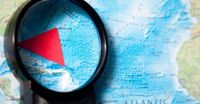For generations, the Bermuda Triangle has loomed large in the public imagination—a mysterious stretch of ocean said to swallow ships and planes without a trace, birthing stories of sea monsters, alien abductions, and the lost city of Atlantis. But according to Australian scientist Karl Kruszelnicki, the real story is far less sensational, and he’s not shy about saying so. In fact, he’s been poking holes in the legend since at least 2017, and his latest statements, published on August 13, 2025, are as blunt as ever: the Bermuda Triangle’s so-called mysteries are simply the product of nature’s fury, human fallibility, and a whole lot of busy traffic.
Kruszelnicki’s argument, as reported by Supercar Blondie and VICE, is straightforward: “The number of ships and planes that vanish here is the same – percentage-wise – as anywhere else in the world.” He isn’t alone in this assessment. Lloyd’s of London, the world-renowned insurance market, has long maintained that there’s nothing statistically unusual about the Bermuda Triangle. The National Oceanic and Atmospheric Administration (NOAA), as well as the US Coast Guard, back up this view, pointing to a combination of natural forces and human error as the real culprits behind the disappearances.
So, what makes this patch of ocean—bounded by Florida, Bermuda, and the Greater Antilles—such a magnet for myth? For starters, it’s one of the busiest travel corridors on Earth. Ships and planes are constantly passing through, increasing the odds that accidents will happen. “It’s just busy,” Kruszelnicki notes, and the numbers bear him out. Proportionally, just as many vessels go missing in other heavily trafficked parts of the world. The difference? The Bermuda Triangle has a much better publicist.
NOAA offers a pragmatic explanation for the area’s reputation, stating, “The combined forces of nature and human fallibility outdo even the most incredulous science fiction.” The Gulf Stream, a powerful ocean current, can transform calm seas into chaos in a matter of minutes. The Caribbean’s maze of islands presents a navigation nightmare, and in certain spots, a ship’s compass might point to true north instead of magnetic north—a small but potentially disastrous detail. Throw in sudden, severe thunderstorms that can appear out of nowhere, and you have a recipe for trouble.
Take the infamous case of Flight 19, for example. In 1945, five Navy bombers vanished while on a training mission. The story has fueled decades of speculation about supernatural forces at work, but Kruszelnicki and other experts see it differently. According to their analysis, the planes were lost in bad weather, and navigational confusion made a bad situation worse. No aliens, no time portals—just a tragic combination of environmental hazards and human mistakes.
Despite these scientific explanations, the myths surrounding the Bermuda Triangle show no signs of fading. As reported by Supercar Blondie, “Let’s be honest – ‘compass malfunction’ isn’t as fun as ‘alien tractor beam.’ The Bermuda Triangle is continuously seen in books and movies because cursed oceans sell.” It’s a sentiment echoed by VICE, which notes that aliens and Atlantis are simply “more fun to imagine,” and for some, believing in these fantastical tales is more comforting than accepting the mundane reality.
Kruszelnicki’s efforts to debunk the supernatural claims have been supported by a chorus of scientific voices. Since the 1970s, Lloyd’s of London has refused to charge higher insurance rates for ships passing through the Bermuda Triangle, citing the lack of statistical evidence for increased danger. NOAA, for its part, has consistently highlighted the role of volatile weather, difficult navigation, and human error in explaining most incidents. As Popular Mechanics reported, there are “no interdimensional sea demons or aliens sucking up World War II pilots.”
Still, the legend persists, fueled by pop culture and a collective desire to believe in something mysterious lurking just beyond the horizon. “Like any good urban legend, the Triangle has a kind of pop culture immunity,” writes Supercar Blondie. “Once it’s in the bloodstream, it’s almost impossible to kill.” The myth endures not because it can’t be solved, but because, as Kruszelnicki suggests, “we’d rather not.”
It’s easy to see why the Bermuda Triangle remains such a compelling story. The idea of an ordinary stretch of ocean being home to extraordinary forces taps into something primal—a fear of the unknown, a fascination with the unexplained. But as the evidence piles up, the case for a supernatural Bermuda Triangle grows weaker by the year. The reality is that this area, while dangerous, is no more perilous than other busy maritime regions. The accidents and disappearances that have occurred are tragic, but they are not unique, nor are they inexplicable.
For those who still cling to the legend, Kruszelnicki’s message is clear: “Stop blaming a ship’s disappearance on aliens and start blaming it on basic math and bad planning.” It may not make for a blockbuster movie, but it has the virtue of being true. The Bermuda Triangle, far from being a portal to another dimension, is simply a place where the odds—and the weather—sometimes catch up with travelers.
Yet, the allure of the unknown is hard to shake. As long as there are stories to tell and mysteries to ponder, the Bermuda Triangle will likely remain in the public consciousness, a symbol of our enduring curiosity (and maybe, just maybe, our reluctance to let go of a good story). For now, though, the scientific consensus stands firm: the Bermuda Triangle’s greatest mystery may be why we’re still so eager to believe in it.
In the end, the legend sails on—facts overboard, myths at the helm, and the truth quietly bobbing in the waves, waiting for anyone willing to look a little closer.
